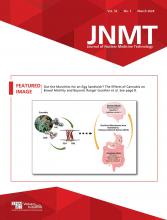Abstract
Metastatic neuroendocrine neoplasms (NEN) of the parotid gland, with discordant histopathology reports between primary parotid tumor (poorly differentiated small cell neuroendocrine carcinoma) and large hepatic metastasis (atypical carcinoid with moderately differentiation status, Ki-67 15-20%), and the value of dual tracer PET-CT imaging (68Ga-DOTATATE and 18F-FDG) features in such clinical setting are illustrated. Minimal 68Ga-DOTATATE and high grade 18FDG uptake of the lesions indicated a poor differentiation status helped in clarifying tumor biology, with its potential implications for subsequent treatment-decision individualization in favor of chemotherapy. The findings underscore the clinical utility of dual tracer PET-CT in appropriating the assessment in patients/situations with conflicting or discordant histopathology at two sites in an individual.







